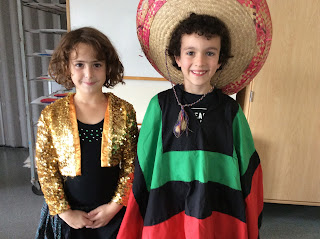October Spanish News
The Science of Storytelling: T.P.R.S.
For over 2,000 years, since the first cave paintings were discovered, telling stories has been one of our most fundamental communication methods.
Lower Elementary students wrote their own stories using some of the words that they have been working on.
LE students are creating their own characters. Visual stimulation helps them understand the story.
They presented their story to their classmates. Our brains become more active when we tell stories.
Another activity the students enjoy is bringing cultural items from around the world and presenting them to their group.
Cultural presentations, dancing, and games are very important parts of learning another language.
Middle Elementary students are working on putting stories in chronological order and then writing their own versions of the story. Simple stories are more successful than the complicated ones.
The students are reading the stories they wrote. We all enjoy a good story when our friends are explaining it to us.
Students improvise a play about the story they are working on. Fun!
Middle Elementary students are also working with the novel Houdini. It is about a boy who changed his name to Houdini. His parents went away for a week and his grandmother stayed with him. Before they left for their vacation, the parents told him not to do certain things. The story discusses cars, as well as good vs. bad. We drew a graph with some examples of good (bueno) things and bad (malo) things. It was a great activity!
ME students made their own commercials about cars in order to reinforce the vocabulary surrounding cars that was presented in the novel Houdini. The commercials included one for a car wash, and another for a repair shop. Visuals and movements make the video fun and easy to follow. Students worked with a partner and had a great time making the video. They even washed my own car!
Upper Elementary students who are working with Brandon Brown Quiere un Perro (Brandon Brown Wants a Dog) finished chapter 3. They did a presentation on the three chapters. This is an important part of understanding the story.
Another work was to change words and sentences from plural to singular.
Students who are working with Noches Misteriosas en Granada created a graph about similarities between Granada and the United States.
They finished chapter 2 from the novel Noches Misteriosas en Granada. The students wrote details that they remembered from those chapters.
Who hears a song and can't get it out of their mind? We heard the song Paraiso, and the students really wanted to learn it. Here is the proof!
Palabras Positivas (Positive Words)
Upper Elementary students have been working with a list of positive words. They use these words in sentences, stories, plays, and other activities.
Middle School students have been working with the Spanish/English dictionary, finding words that they don’t know. Each word has more than nine letters. They formed sentences using the words and played charades. It was really fun!
They are also working with grammatical rules like masculine/ feminine, plural/singular, indefinite articles, pronouns, verb conjugations, and more. These grammar concepts are part of the novel Robo en la Noche, which the students are working on.
One Middle School was to make a video with their partner. It was a great activity to practice using past tense verbs. They were GREAT!

















These videos were so wonderful to watch. It's so fun to see the students progress in Spanish over the years!
ReplyDelete